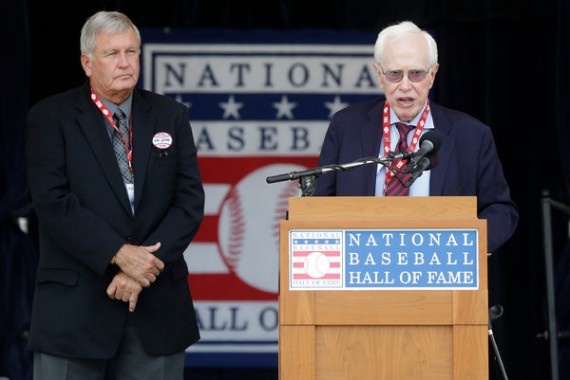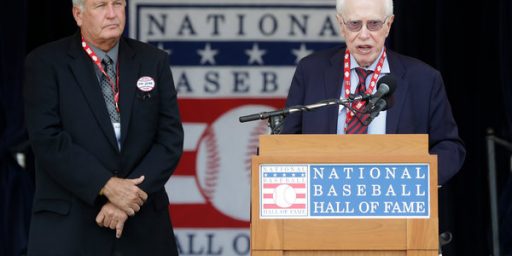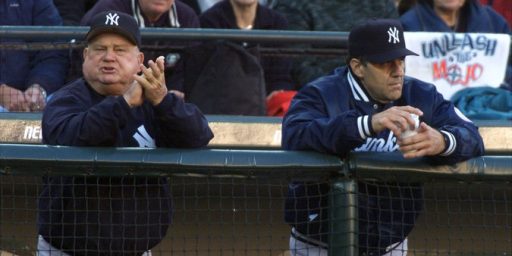Baseball Honors Dr. Frank Jobe, Originator Of Tommy John Surgery
The doctor who came up with a surgical technique that has extended the careers of countless numbers of Major League pitchers was honored yesterday at the Baseball Hall of Fame:
COOPERSTOWN, N.Y. — Dr. Frank Jobe, retired surgeon, and Tommy John, retired pitcher, sat together Saturday recalling their intertwined history: the surgery that Jobe performed in 1974 when he replaced the ruptured ulnar collateral ligament in John’s left elbow with the palmaris longus tendon from his right wrist.
It had never been done, but it has been done hundreds of times since.
Jobe and John make for sports medicine’s best-known athlete and surgeon. Yet what Jobe did is called Tommy John surgery, not Frank Jobe surgery. Jobe did a work of medicine and imagination for a 31-year-old pitcher who felt searing pain in his elbow while delivering a pitch to Hal Breeden of the Montreal Expos in July 1974. So the name went to the surgery’s first beneficiary.
Had John not needed Jobe, the surgery might be named for Brent Strom, whom Jobe operated on next, but only after he saw that John was recovering.
Jobe was honored Saturday by the National Baseball Hall of Fame in a ceremony at Doubleday Field for his pioneering role in pitcher survival. John, standing beside Jobe, whom he met while playing in Los Angeles, said, “I’m glad that I pitched so badly for the White Sox so that Roland Hemond traded me to the Dodgers.”
“We did a little bit of surgery for him,” Jobe said, gesturing to John. “But the man himself did the hard work. He developed a rehabilitation program that stood the test of time.”
Jobe proudly described how John pitched 13 more seasons and won 164 more game after the operation.
“And that,” the 88-year-old Jobe said, “is sports medicine.”
If he had thought of the surgery a decade earlier, Jobe might have extended Sandy Koufax’s career. But at the time, Koufax decided that the pain in his left arm was too severe to continue pitching, Jobe was just establishing his orthopedic practice with Dr. Robert Kerlan.
The surgery was revolutionary at the time that Tommy John had it, and there was many doubts at the time that he’d ever have a real career again afterwards, but he ended up being named NL Comeback Player Of the Year. As noted, John went on to play for another 13 years for the Dodgers, Yankees, Angels and Athletics before retiring in 1989 with 288 wins. Jobe’s surgery, meanwhile, has gone on to become commonplace in baseball, although both he and John noted that it seems to be being performed on younger and younger players:
Jobe and John are alarmed by the numbers of 12- to 17-year-olds who are having the operation.
“It’s like an epidemic, and it’s going to grow exponentially,” John said. “These kids are rupturing the ligament. They’re playing year-round baseball.” Justin Verlander, he argued, does not pitch-year round. Why do teenagers?
“The ligament needs rest,” Jobe said.
So it would seem. One of the most notable recent examples that seems to prove this is Washington Nationals Pitcher Stephen Strasburg, who was sent for Tommy John surgery within two months after his Major League debut, in no small part due to the stress that his unusual pitching style put on the ligaments at issue. The same things appear to be happening to these young kids, which means the prospect of more than one instance of this kind of surgery over the course of one’s career is now a distinct possibility.
Photo of Tommy John and Dr. Frank Jobe via New York Times







Jobe? This reminds me that Tommy John himself should be in the Hall of Fame.
288-231 W/L, 3.34 ERA, 2245 SO, and he was a key pitcher on winning teams. Jack Morris is very deserving too. The HOF voters are usually out-to-lunch.
He should be. Sadly, his last chance with the Baseball Writers was in 2009 and he fell unceremoniously short. If he’s going to make it in, it will be up to the Veterans Committee at this point. Considering that there are players with records near identical to his already in the hall,
And I agree with you about Jack Morris too.
@Doug Mataconis:
For years I thought that Jack Morris and Bert Blyleven were unfairly overlooked – they finally got around to Blyleven, and hopefully Morris will get by sometime later on. I truly believe that if Morris had done his work with the Yankees or the Dodgers that he would be in by now.
Wins are overrated – as is Morris’s candidacy.
(Now there is a way to start a massive internet flame war!)
Seriously, here is the best case for Morris, whether it is convincing is another matter…
Tommy John receiving “Tommy John” surgery, I mean, what are the odds?
Same with Lou Gehrig getting Lou Gehrig’s Disease.
Speaking of Jack Morris there was an old joke in the late 80s,
1.) Who led the MLB in wins from 1983 – 1992?
– Jack Morris
2.) Who hit the most home runs from 1984 – 1992?
– Griffey Jr.
3. Who got hit with the most balls in the 80s?
– Liberace